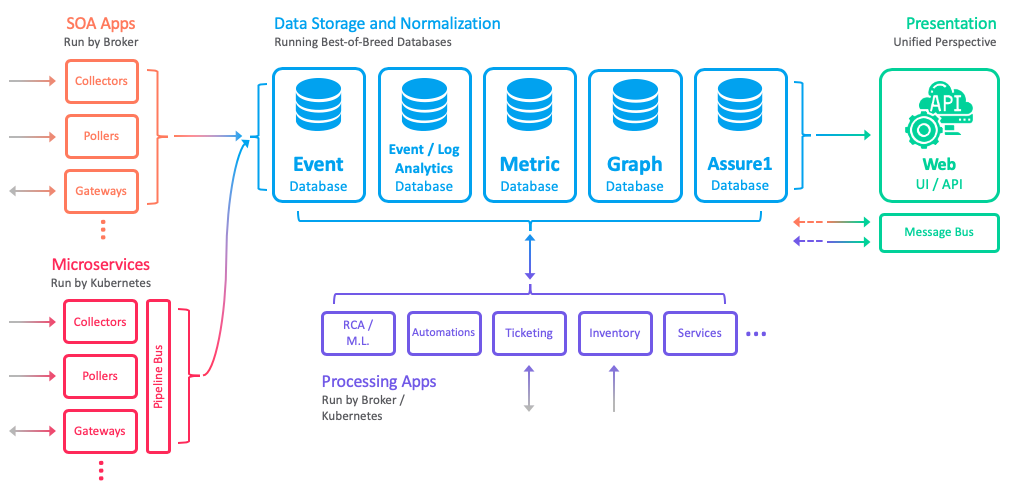What is Unified Assurance?
Introduction
Unified Assurance enables you to manage services on a single platform: this includes silo’d tools that run across varied and hybrid networks to ensure availability of communications, information, and product offerings.
Unified Assurance enables:
-
Consolidation and management of legacy tools.
-
Visibility and control of end-to-end services.
-
Operationalize network functions virtualization (NfV) for production.
-
Automation of redundant and repetitive Service Management tasks.
-
Consolidation of data to a single source of truth.
Unified Assurance brings together fault, performance, topology and service level management in a single scalable software platform. This unification provides significant performance, scalability and cost advantages over legacy and silo tool sets, resulting in an improved user experience.
Unified Assurance Hyperscale Architecture

Description of illustration unified-assurance-hyperscale-architecture.png
What’s New in the Architecture
In this section we will detail what’s new in Unified Assurance. Unified Assurance is built on a three-tier architecture. The following list shows you the three layers and highlights what’s new in the respective layers. A brief description is given to the new technologies.
-
The Presentation Layer has elements that will be familiar to v4 administrators and users, this layer also contains new elements:
-
Message Bus - RabbitMQ is a message-queuing software that is new in Unified Assurance. RabbitMQ reduces load and delivery times.
-
UI / API:
-
Apache.
-
Ext JS.
-
PHP.
-
-
Analytics UI - Kibana is the front-end to Elastic Stack. Kibana visualizes the Elasticsearch data.
-
Metrics Dashboard - Grafana allows Unified Assurance to query, visualize and understand metrics.
-
-
The Database Layer, like the Presentation layer, contains new and familiar elements:
-
Management - MySQL.
-
Events - MySQL.
-
Graph - Neo4j is an open-source NoSQL database management system.
-
Historical - ElasticSearch is an open-source, RESTful, distributed search and analytics engine built on Apache Lucene.
-
Metric - InfluxDB is an open-source time series database (TSDB).
-
-
Finally, new elements can also be found in the Collection and Processing Layer:
-
Broker - Perl.
-
Applications - Perl.
-
Log Ingestion - Beats is the platform for single-purpose data shippers.
-
Metrics Ingestion - Telegraf is part of the TICK Stack and is a plugin-driven server agent for collecting and reporting metrics.
-
Microservices - Understanding Microservices
-
A Deeper Dive
This section takes a looks at what’s new in the respective four areas of Fault Management, Performance Management, Topology Architecture, and finally Configuration Management. The technologies mentioned in the first section will be placed in the context of the Low-Latency Information Stack.
Unified Assurance Fault Architecture
-
The Presentation Layer consists of: Event Lists, Dashboards, Diagrams, and Analytics.
-
The Unified Assurance Cognitive Engine (ACE) Processing Layer consists of the SLM Engine, Watcher, CAPE, RCA, Mechanizations, Analytics Ingestor, Ticket Connector, and Machine Learning.
-
The Oracle Communications InfoLake takes data from the ACE Processing Layer and the Collection Layer. The concept of the Oracle Communications InfoLake is new in Unified Assurance. It consists of:
-
Real Time Events.
-
Event Analytics using ElasticSearch.
-
-
The following list shows the two sets of elements in the Collection Layer. The first set of elements takes data from the network, conversely the second set of elements sends data to the network:
-
FIFO, PIPE, SMTP, Syslog, TCPServer, Trap, and WebHook.
-
Generic Agent, Generic Connector, Generic DB, eMail, TCP Clients, and TL1.
-
Unified Assurance Performance Management Architecture
-
The Presentation Layer consists of: Metric Overview & Charts, Dashboards, Diagrams, and Analytics.
-
The Unified Assurance Cognitive Engine (UACE) Processing Layer consists of Post Calculations, SLM Engine, Standard Threshold Engine, Trend Threshold Engine, Abnormal Threshold Engine, and the Missing Data Threshold Engine.
-
The Oracle Communications InfoLake takes data from the ACE Processing Layer and the Collection Layer. The Oracle Communications InfoLake consists of the Metrics DB powered by InfluxDB.
-
The following list shows the three sets of elements in the Collection Layer. The first and second sets of elements sends data to the network, conversely the third set of elements takes data from the network:
-
Custom Poll Discovery, PIPE Discovery, Discovery Agent, Device Discovery, SNMP Discovery, and SNMP Interfaces.
-
Ping Poller, Generic Poller, Generic DB, SNMP Poller, Network IF Poller, TCP Client Poller and the Transaction Poller.
-
File and TCP Servers.
-
Unified Assurance Topology Architecture
-
The Presentation Layer consists of: Network Details, Dashboards, Diagrams and Analytics.
-
The Unified Assurance Cognitive Engine (ACE) Processing Layer consists of Graph Stitchers and RCA.
-
The Oracle Communications InfoLake takes data from the ACE Processing Layer and the Collection Layer. The Oracle Communications InfoLake in this instance consists of Topology Database powered by Neo4j.
-
The following list shows the two sets of elements in the Collection Layer. The first set of elements sends data to the network, conversely the second set of elements takes data from the network:
-
Gather Network Inventory, Database Stitcher, TCP Client Stitcher, Subversion Stitcher.
-
File Stitcher and TCP Server Stitcher.
-
Unified Assurance Configuration Management Architecture
-
The Presentation Layer consists of: Dashboards, Diffs and History.
-
The Oracle Communications InfoLake uses Config DB.
-
The following elements in the Collection Layer interface with your network, Config Discovery and Gather Configs (e.g. SSH and Telnet).
Event.Events
In Unified Assurance the Events.Alarm DB schema has been renamed to Event.Events. Fields have been renamed, and new fields have been added. Exact details are highlighted in the Understanding the Default Events Fields documentation where we have included the complete list of fields.